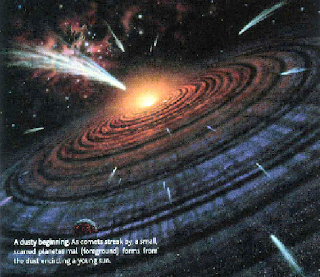Giant Molecular Clouds
Space between stars in a galaxy is nearly empty, except for a scattering ofhydrogen atoms. The atoms are so far apart that, if an atom were an average- size
person, each person would be separated by about 465 million miles, which is the
distance between our Sun and Jupiter. These atoms are moving very fast because
they are extremely hot, baked by ultraviolet radiation from stars. This makes it
difficult for atoms to bond to form molecules. Those that do form don't last for
long. If radiation doesn't break these molecules apart, a chance encounter with
another atom will.
Some parts of space, however, are not wide open frontiers containing a few
atoms. These cosmic spaces comprise dense clouds of dust and gas left over from
galaxy formation. Since these clouds are cooler than most places, they are perfect
breeding grounds for star birth. When the density is 1,000 times greater than what
is found in normal interstellar space, many atoms combine into molecules, and the
gas cloud becomes a molecular cloud. Like clouds in our sky, these molecular
clouds are puffy and lumpy. Molecular clouds in our Milky Way Galaxy have
diameters ranging from less than 1 light-year to about 300 light-years and contain
enough gas to form from about 10 to 10 million stars like our Sun. Molecular
clouds that exceed the mass of 100,000 suns are called Giant Molecular Clouds.
A typical full-grown spiral galaxy contains about 1,000 to 2,000 Giant
Molecular Clouds and many more smaller ones. Such clouds were first discovered
in our Milky Way Galaxy with radio telescopes about 25 years ago. Since the
molecules in these clouds do not emit optical light, but do release light at radio
wavelengths, radio telescopes are necessary to trace the molecular gas and study its
physical properties. Most of this gas is very cold—about -440 degrees (°)
Fahrenheit (F) or -262 degrees Celsius (C)—because it's shielded from ultraviolet
light. Since gas is more compact in a colder climate, it is easier for gravity to
collapse it to form new stars.
Ironically, the same climate that is conducive to star formation also may shut
off the star birth process. The problem is heat. Young stars are very hot and can
heat the molecular gas to more than 1,000º F (537º C), which is an unfavorable
climate for star birth. When the temperature exceeds about 3,000º F (1648º C), the
gas molecules break down into atoms.
The density of the gas can increase considerably near the centers of some
Giant Molecular Clouds: Gas as dense as 1 billion molecules per cubic inch has
been observed. (Though dense by astronomical standards, such gas is still 100
billion times thinner than the air we breathe here on Earth at sea level!) In such
dense regions, still denser blobs of gas can condense and create new stars.
Although the star formation process is not fully understood, there is observational
evidence that most stars are born in the densest parts of molecular clouds.
What happens when stars begin forming in Giant Molecular Clouds depends
on the environment. Under normal conditions in the Milky Way and in most other
present-day spiral galaxies, star birth will stop after a relatively small number of
stars have been born. That's because the stellar nursery is blown away by some of
the newly formed stars. The hottest of these heat the surrounding molecular gas,
break up its molecules, and drive the gas away. As the celestial smog of gas and
dust clears, the previously hidden young stars become visible, and the molecular
cloud and its star-birthing capability cease to exist. In 1995 the Hubble Space
Telescope revealed such an emerging stellar nursery in the three gaseous pillars of
the Eagle Nebula M16.
 The Eagle Nebula M16 (above) is a nearby star-forming region 7,000 lightyears
The Eagle Nebula M16 (above) is a nearby star-forming region 7,000 lightyearsaway in the constellation Serpens.
Above is a massive star forming region in the Eagle Nebula. These pillars of
gas are approximately six trillion miles high.


Circumstellar Disk of Star Formation
A star forms through the gravitational collapse of a vast cloud of interstellarhydrogen. According to theory, and confirmed by previous Hubble pictures, a
dusty disk forms around the newborn star. As material falls onto the star, some of it
can be heated and ejected along the star's spin axis as opposing jets. These jets of
hot gas blaze for a relatively short period of the star's life, less than 100,000 years.
However, that brief activity can predestine the star's evolution, since the final mass
of a star determines its longevity, temperature, and ultimate fate.

Diagram of Circumstellar Disk and Jets
The jet might carry away a significant fraction of the material falling intoward the star, and, like a hose's water stream plowing into sand, sweeps out a
cavity around the star that prevents additional gas from falling onto the
circumstellar disk. The disk can be seen to "flare" away from the star. (It is thicker
at larger distances from the star.) This behavior can be understood because it takes
material farther out in the disk longer to settle to the disk midplane.

The Early Solar System
When the star becomes hot enough it will stop accreting material and blowaway much of the disk—but perhaps not before planets have formed around the
star. The generally accepted theory for the creation of our solar system is that it
formed from a disk, and that the orbits of the planet are the "skeletal" remnant of
the disk. It also explains why the planets all orbit the Sun in the same direction and
roughly the same plane.
